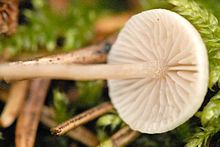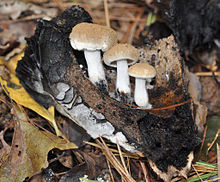- Collybia cookei
-
Collybia cookei 
Scientific classification Kingdom: Fungi Phylum: Basidiomycota Class: Basidiomycetes Order: Agaricales Family: Tricholomataceae Genus: Collybia Species: C. cookei Binomial name Collybia cookei
(Bres.) J.D.ArnoldSynonyms[1] 1928 Collybia cirrhata var. cookei Bres.
1979 Microcollybia cookei (Bres.) Lennox
1987 Collybia tuberosa var. cookei (Bres.) Bon & Courtec.Collybia cookei Mycological characteristics 
gills on hymenium 

cap is convex
or flat
hymenium is adnate 
stipe is bare 
spore print is white 
ecology is saprotrophic 
edibility: unknown Collybia cookei is a species of fungus in the Tricholomataceae family, and one of three species in the genus Collybia. It is known from Europe, Asia, and North America. The fungus produces fruit bodies that usually grow on the decomposing remains of other mushrooms, like Meripilus giganteus, Inonotus hispidus, or species of Russula; occasionally fruit bodies are found on rich humus or well-decayed wood. The fungus produces small white mushrooms with caps up to 9 mm (0.35 in) in diameter, supported by thin stems that originate from a yellowish-brown sclerotium. The mushroom is difficult to distinguish from the other two species of Collybia unless an effort is made to examine the sclerotia, which is usually buried in the substrate. The edibility of the mushroom has not been determined.
Contents
Taxonomy and phylogeny
Collybia cookei
Dendrocollybia racemosa
Clitocybe connata
Hypsizygus ulmarius
Lepista nuda
Phylogeny and relationships of C. cookei and closely related fungi based on ribosomal DNA sequences.[2] The species was first described in the scientific literature in 1928 as Collybia cirrhata var. cookei by the Italian mycologist Giacomo Bresadola.[3] In a 1935 publication, Jean D. Arnold reported a series of cultural studies with monokaryon isolates (hypha having only a single haploid nucleus) of several Collybia species to determine their mating type. All attempts to produce hybrids between C. cirrhata var. cookei and C. cirrata or mycelial fusions between the two species failed. This sexual incompatibility indicated that the two taxa were separate species, and she raised the taxon from varietal to specific status, calling it Collybia cookei.[4] The species has also been called Microcollybia cookei in a 1979 publication by Joanne Lennox,[5] but the genus Microcollybia has since been folded into Collybia.[6] Marcel Bon and Régis Courtecuisse considered the species a variety of Collybia tuberosa in a 1988 publication.[7] A 2001 molecular analysis based on the ribosomal DNA sequences confirmed that C. cookei is phylogenetically related to C. tuberosa and C. cirrhata, and that the three species form a monophyletic group that comprise the genus Collybia.[2]
The specific epithet cookei honors the British mycologist Mordecai Cubitt Cooke.[8]
Description
The caps of young mushrooms are roughly spherical, but soon become convex to flattened in maturity, and reach diameters of 2–9 mm (0.08–0.35 in).[9] The cap margin is rolled or curled inward when young, but straightens out as it matures.[10] The cap color is white to cream. The gills are broadly adnate to slightly decurrent, with a color similar to the cap; their spacing is close to subdistant.[11] The whitish stem is equal in width throughout, usually not straight but with curves, and 2–5 cm (0.8–2.0 in) long by 0.3–1.0 mm (0.01–0.04 in) thick.[9] The upper region of the stem surface can be covered with what appears to be a white powder, and there are thin hairs near the base.[10] The stems originate from a yellowish-brown sclerotium that is up to 6 mm (0.24 in) long.[9] The sclerotium ranges in shape from roughly spherical to almond-shaped to irregular, and its surface is often wrinkled and pitted.[12] The mushroom has no distinctive odor or taste, and its edibility is unknown.[10]
In deposit, the spore color is white. The spores are smooth, ellipsoidal to tear-shaped,[10] hyaline (translucent), not amyloid, and measure 3.9–5.2 by 2.6–3.3 μm. The basidia (spore-bearing cells in the hymenium) are four-spored and hyaline, with dimensions of 16–20 by 4–5 μm. They have clamps at their bases. There are no cystidia on either the edges (cheilocystidia) or faces (pleurocystidia) of the gills. The arrangement of the hyphae in the hymenophoral tissue varies from regular to interwoven. The cap cuticle is a cutis (a type of tissue where the hyphae are arranged more or less parallel to the surface), formed by hyphae with septa, roughly 4–9 μm in diameter. Clamp connections are present in the hyphae. The sclerotium is made of hyphae that have yellow pigment in their walls that appear in cross-section to be pseudoparenchymatous (compactly interwoven short-celled hyphae that resemble parenchyma of higher plants), and measure 5–10 μm in diameter.[9]
Similar species
Collybia cookei is most likely to be confused with the two other members of Collybia, both of which are outwardly similar in appearance; distinguishing between the three typically requires excavating the stem base away from the moss or debris in which the stem is embedded.[8] In the field, C. tuberosa may be distinguished from C. cookei by its dark brown sclerotia that somewhat resembles an appleseed.[11] Using a microscope provides a more definitive way of distinguishing the two: the hyphae in the sclerotia of C. cookei are rounded, while those of C. tuberosa are elongated; this diagnostic character is apparent with both fresh and dried material of the two species.[13] C. cirrhata does not produce sclerotia.[10]
Another mushroom that grows on decomposing fruit bodies is Asterophora lycoperdoides, which is distinct from C. cookei because of the powdery brown asexual spores (chlamydospores) produced on the cap surface.[14] Alexander H. Smith has noted a general similarity in appearance between C. cookei and the North American species Clitocybe sclerotoidea (then known as Tricholoma sclerotoideum),[15] which is parasitic to Helvella lacunosa.[16] However, C. sclerotoidea is larger than C. cookei, with cap diameters up to 3 cm (1.2 in), and has more distantly spaced gills.[15]
Habitat and distribution
Like all members of the genus Collybia, C. cookei grows on the well-rotted, blackened remains of mushrooms, such as species of Russula,[9] Meripilus giganteus,[17] and Inonotus hispidus.[18] Fruit bodies occasionally grow on well-decayed wood[10] or rich humus.[8] The fruit bodies grow scattered, clustered, or in groups.[9] A field study conducted near a Brass mill in Sweden revealed that heavy metal contamination had little effect on the appearance of the mushroom, possibly because its substrate of partially decomposed fruit bodies has a lower metal concentration that the underlying topsoil.[19]
Collybia cookei is found in Europe, Asia (Japan), and North America.[9] The European distribution extends north to the Arctic Circle and the Lofoten Islands.[20] The species is widely distributed in North America;[11] it was reported from Mexico for the first time in 1998.[21] The fungus is partial to mixed forest dominated by aspen and conifers in montane and subalpine environments.[8] In The Netherlands, it was a component of one of three communities of saprobic fungi associated with roadside verges (the land between the road edge and the adjacent wall, fence or hedge) planted with common oak (Quercus robur); the verges also supported the growth of the mushroom Russula ochroleuca, a host of C. cookei.[22]
References
- ^ "Collybia cookei (Bres.) J.D. Arnold 1935". MycoBank. International Mycological Association. http://www.mycobank.org/MycoTaxo.aspx?Link=T&Rec=416229. Retrieved 2010-12-19.
- ^ a b Hughes KW, Petersen RH, Johnson JE, Moncalvo J-E, Vilgalys R, Redhead SA, Thomas T, McGhee LL. (2001). "Infragenic phylogeny of Collybia s. str. based on sequences of ribosomal ITS and LSU regions". Mycological Research 105 (2): 164–72. doi:10.1017/S0953756200003415.
- ^ Bresadola G. (1928). Iconographia Mycologica. 5. Milano. p. 206.
- ^ Arnold JD. (1935). "A comparative study of certain species of Marasmius and Collybia in culture". Mycologia 27 (4): 388–417. http://www.cybertruffle.org.uk/cyberliber/59350/0027/004/0388.htm.
- ^ Lennox JW. (1979). "Collybioid genera in the Pacific Northwest". Mycotaxon 9 (1): 117–231. http://www.cybertruffle.org.uk/cyberliber/59575/0009/001/0117.htm.
- ^ Kirk PM, Cannon PF, Minter DW, Stalpers JA. (2008). Dictionary of the Fungi (10th ed.). Wallingford, UK: CABI. p. 424. ISBN 9780851998268.
- ^ Bon M. (1988). "Clé monographique des russules d'Europe" (in French). Documents Mycologiques 18 (70–71): 38.
- ^ a b c d Evenson VS. (1997). Mushrooms of Colorado and the Southern Rocky Mountains. Englewood, Colorado: Westcliffe Publishers. p. 89. ISBN 978-1565791923. http://books.google.com/books?id=EAeDeyqZLq0C&lpg=PR9&dq=collybia%20cookei&pg=PA89.
- ^ a b c d e f g Treu R. (1996). "Collybia cookei". IMI Descriptions of Fungi and Bacteria (128): sheet 1271. ISSN 0009-9716. http://www.springerlink.com/content/x5457xt520wk5264/fulltext.pdf.
- ^ a b c d e f Bessette AE, Roody WC, Bessette AR. (2007). Mushrooms of the Southeastern United States. Syracuse, New York: Syracuse University Press. p. 122. ISBN 978-0815631125. http://books.google.com/books?id=IB1Gv3jZMmAC&lpg=PA122&dq=collybia%20cookei&pg=PA122.
- ^ a b c Kuo M. (May 2008). "Collybia cookei". MushroomExpert.Com. http://www.mushroomexpert.com/collybia_cookei.html. Retrieved 2010-12-20.
- ^ Halling RE. (14 July 2009). "Collybia sensu stricto". A revision of Collybia s.l. in the northeastern United States & adjacent Canada. http://www.nybg.org/bsci/res/col/collsp.html#cirrhata. Retrieved 2010-12-23.
- ^ Komorowska H. (2000). "A new diagnostic character for the genus Collybia (Agaricales)". Mycotaxon 75: 343–46. http://www.cybertruffle.org.uk/cyberliber/59575/0075/0343.htm.
- ^ Roody WC. (2003). Mushrooms of West Virginia and the Central Appalachians. Lexington, Kentucky: University Press of Kentucky. p. 490. ISBN 0-8131-9039-8. http://books.google.com/books?id=5HGMPEiy4ykC&lpg=PA510&dq=collybia%20cookie&pg=PA490.
- ^ a b Smith AH. (1944). "New North American agarics". Mycologia 36 (3): 242–62. doi:10.2307/3754821. http://www.cybertruffle.org.uk/cyberliber/59350/0036/003/0242.htm.
- ^ Ammirati J, Trudell S. (2009). Mushrooms of the Pacific Northwest: Timber Press Field Guide (Timber Press Field Guides). Portland, Oregon: Timber Press. p. 283. ISBN 0-88192-935-2.
- ^ Veselsky J. (1966). "A remarkable case of coexistence of Collybia cookei with Grifola gigantea". Mykologicky Sbornik 43 (3–4): 33–35. ISSN 0374-9436.
- ^ Noordeloos ME. (1994). "[Collybia cookei growing on Inonotus hispidus]" (in Dutch). Coolia 37 (1): 32.
- ^ Rühling Å, Bååth E, Nordgren A, Söderström B. (1984). "Fungi in metal-contaminated soil near the Gusum brass mill, Sweden". Ambio 13 (1): 34–36.
- ^ Papetti CEG. (1999). "Scandinavia: sulle orme dei grandi naturalisti nordici, a contatto con una natura incontaminata – Parte I [Scandinavia: in the footsteps of the great Nordic naturalists, in touch with uncontaminated nature – Part I]" (in Italian). Rivista di Micologia 42 (2): 119–39. ISSN 0394-9486.
- ^ Villarruel-Ordaz JL, Cifuentes J. (1998). "First record of Collybia cookei (Tricholomataceae, Agaricales) from Mexico" (in Spanish). Revista Mexicana de Micologia 14: 61–63. ISSN 0187-3180.
- ^ Keizer PJ. (1994). "Mycocoenology of roadside verges planted with common oaks (Quercus robur L.) in Drente, The Netherlands". Nova Hedwigia 58 (3–4): 405–36.
External links
Categories:- Fungi of Asia
- Fungi of Europe
- Fungi of North America
- Fungi described in 1928
- Tricholomataceae
Wikimedia Foundation. 2010.




